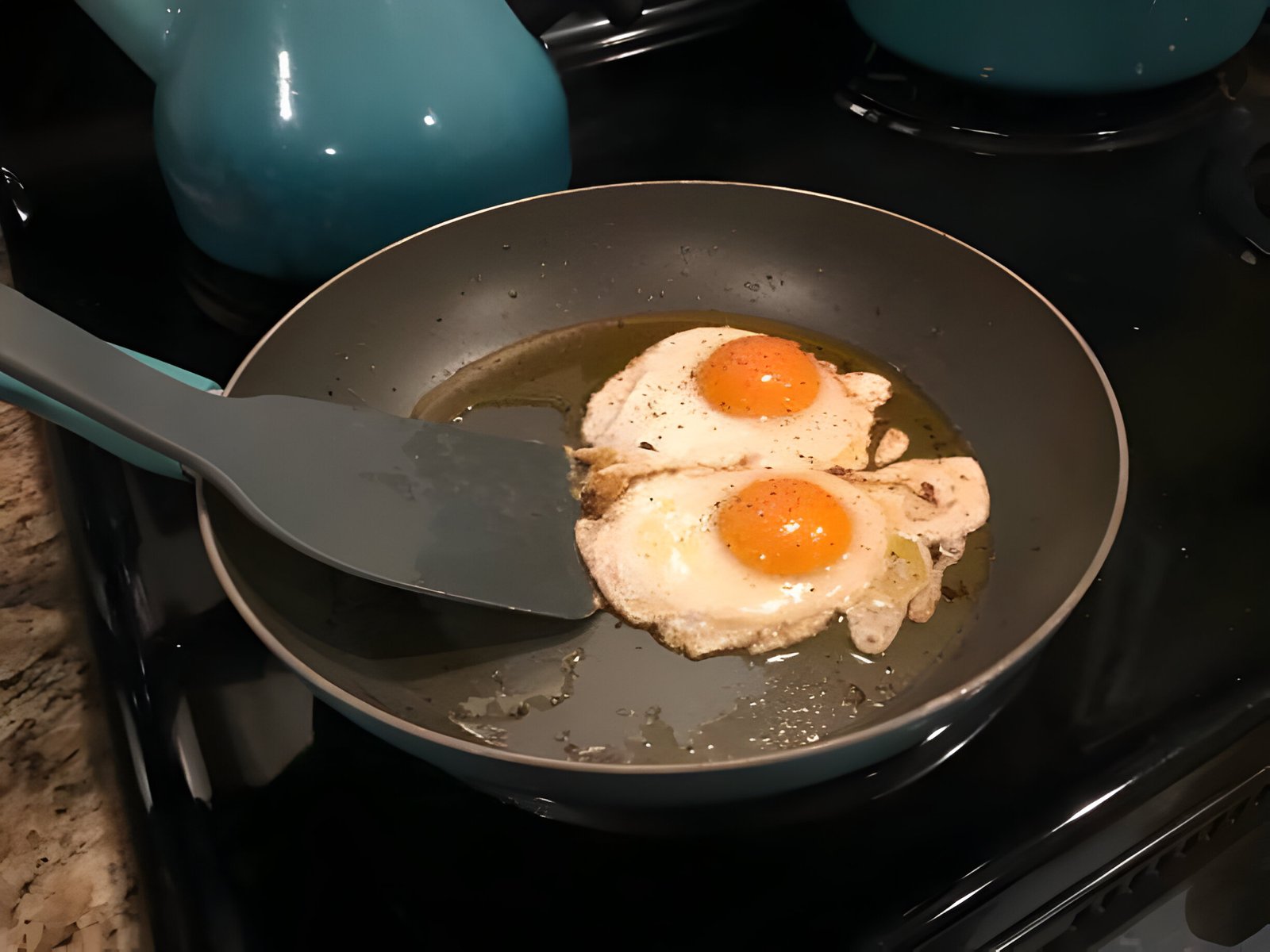Image Credit: GetyImage
For those in pursuit of a hearty breakfast, mastering the art of cooking over medium eggs bridges the gap between the runny yolk of over easy eggs and the fully cooked nature of over hard eggs. Not only do these eggs offer a fetching compromise of textures with their cooked whites and slightly thickened yolks, but they also serve as a protein-rich cornerstone for a multitude of morning dishes. From acting as the crowning glory atop a breakfast sandwich to nestling next to slices of toast perfect for dipping, over medium eggs are a versatile and beloved choice. The right cooking technique ensures the egg white sets completely while the yolk remains in that coveted, slightly runny state, ideal for those who cherish every opportunity to savor the richness of a perfectly cooked egg.
This article offers a comprehensive look into the journey of making the perfect over medium eggs, beginning with an overview of what exactly defines eggs prepared in this style. It delves into the essential ingredients and tools needed—such as butter for frying, salt and pepper for seasoning, and a non-stick pan paired with a spatula for the flawless flip. Step-by-step instructions will guide readers through the cooking process, ensuring the ideal balance between cooking time and heat to achieve that desirable consistency.
What are Over Medium Eggs?
Over medium eggs represent a unique and beloved style of preparing fried eggs, striking a delicate balance in texture between over easy and over hard eggs. The term “over” refers to the method of flipping the egg during cooking, which is a common technique across various styles. In the case of over medium eggs, the cooking process involves allowing the egg whites to fully set while keeping the yolk partially runny, offering a consistency that is neither too liquid nor too firm.
Cooking Process and Texture
When cooking over medium eggs, the egg is first fried on one side until the whites are completely set. It is then carefully flipped to cook the other side, ensuring that the yolk remains intact. The key to achieving the perfect over medium egg lies in the cooking time after flipping. Typically, the egg should be cooked for an additional 30 to 45 seconds on the second side. This allows the yolk to remain slightly runny but with a thicker, jam-like consistency, often described as “jammy” or “oozy.” This texture makes over medium eggs particularly appealing for those who enjoy a bit of yolk to mix with other components of their meal, such as a slice of toast or a breakfast sandwich.
Preferences and Variations
For those who prefer a firmer yolk, cooking for up to two minutes after flipping might be ideal, whereas a shorter cooking time will result in a more liquid yolk.
Over medium eggs are a versatile and satisfying choice for breakfast or any meal, providing a protein-rich option that pairs well with a variety of foods. Whether nestled beside bacon and hash browns or layered onto a warm breakfast sandwich, over medium eggs offer a delightful texture and flavor that many find to be just right—the Goldilocks of fried eggs.
Also Read: How to Perform an Effective Egg Cleanse at Home
Ingredients and Tools Needed
To achieve the perfect over medium eggs, the right ingredients and tools are essential. Here’s a detailed list to ensure you have everything needed for this delightful breakfast staple.
Large Eggs
Freshness is key for the best results. Fresh, large eggs, ideally organic or locally sourced, are recommended as they tend to hold their shape better in the pan and offer superior flavor. Smaller eggs can be used but keep in mind they may cook quicker.
Butter or Oil
A form of fat is crucial to prevent the eggs from sticking to the pan. Options include butter, which adds a rich flavor, or oils such as olive oil, avocado oil, or coconut oil for their high smoke points and health benefits. For those who enjoy a unique flavor, bacon fat is an excellent choice, especially if you’re aiming for crispy edges.
Nonstick Skillet
The type of pan used significantly affects the ease of cooking and quality of your eggs. A nonstick skillet is ideal due to its properties that prevent sticking and allow for easy flipping of the eggs. A well-seasoned cast iron skillet can also be used as an alternative. Ensure the skillet has gently sloped sides for easier maneuvering.
Spatula
The spatula is a critical tool for achieving the perfect flip without breaking the yolk. A thin, flexible spatula, preferably made of silicone or metal, is recommended. Fish spatulas are particularly effective due to their thin, angled edges that slide under the eggs effortlessly.
Salt and Pepper
Seasoning is simple but essential. A pinch of kosher salt and freshly ground black pepper enhance the natural flavors of the eggs. Adjust the seasoning to taste, and consider adding fresh herbs for an extra layer of flavor if desired.
Step-by-Step Instructions for Cooking Over Medium Eggs
Heat the Pan
To start, heat a non-stick frying pan over medium-low heat. Add a half tablespoon of butter or a tablespoon of canola oil, depending on your preference. Allow the butter to melt or the oil to shimmer until it evenly coats the pan. This initial step is crucial as it ensures that the eggs do not stick to the pan and provides a gentle cooking environment that is ideal for achieving the perfect over medium eggs.
Cook the Eggs
Sprinkle a pinch of kosher salt and a few grinds of black pepper over the eggs to enhance their flavor. Cook the eggs for about 2 to 3 minutes. During this time, the whites should begin to set but remain slightly translucent near the yolk, setting the stage for the perfect flip.
Flip and Finish Cooking
Gently flip each egg, taking care not to break the yolks. After flipping, cook the eggs for an additional 45 seconds to 1 minute. This is the critical moment where the yolk firms up slightly but remains jammy — soft with a bit of fluidity, ideal for those who enjoy a bit of yolk to mix with other breakfast components.
Once done, gently transfer the eggs from the pan onto a plate using the spatula. If cooking in batches, repeat the process with the remaining eggs, ensuring each batch receives the same careful cooking.
By following these steps, one can master the art of cooking over medium eggs, achieving a balance of firm whites and creamy, slightly runny yolks every time.
Tips and Tricks for Perfect Over Medium Eggs
To perfect the art of cooking over medium eggs, one must pay attention to several key factors. Here are some essential tips and tricks to guide you:
Use Fresh Eggs
Fresh eggs are crucial for achieving the best results when cooking over medium eggs. They should be no more than a week old to ensure they maintain their shape and do not spread too thinly in the pan.The freshness of the eggs not only impacts the aesthetic but also enhances the overall flavor, making your breakfast both visually appealing and delicious.
Be Patient
Patience is vital when cooking over medium eggs. The eggs need to be cooked slowly over low heat to prevent overcooking and to achieve the perfect consistency of the yolk. Rushing the process can lead to a firm yolk or undercooked whites. It’s important to allow the eggs to cook gently, adjusting the heat as necessary to maintain a low and steady temperature.
Choose the Right Pan
The choice of pan is critical in cooking eggs. A non-stick skillet is ideal because it prevents the eggs from sticking and makes flipping them easier. Pans with gently sloped sides are preferred as they allow for better maneuverability when flipping the eggs. It’s essential to select a pan that conducts heat evenly and efficiently. Additionally, the pan should be easy to clean and maintain, preferably dishwasher safe, although some may require hand washing. Ensure that you use the right size of the pan depending on the number of eggs and the specific dish you are preparing, whether it’s a single over medium egg or a larger dish like a frittata.
By following these tips and using the right techniques and tools, one can master the art of cooking over medium eggs, making them a delightful addition to any meal.
Conclusion
Having explored the nuanced art of cooking over medium eggs, we’ve uncovered the delicate balance that makes these eggs a beloved breakfast choice for many. The journey from selecting fresh, quality eggs to the final flip reveals not just a method but a craft, emphasizing patience and attention to detail to achieve that ideal texture of creamy yolks and fully set whites.
Moreover, the exploration of this culinary skill transcends the kitchen, inviting us to appreciate the joy and satisfaction derived from mastering such a seemingly simple dish. The implications of mastering over medium eggs extend far beyond breakfast, offering a versatile component that enhances any meal with its rich flavor and satisfying texture.
FAQs
1. What is the best method for cooking over easy eggs?
To cook eggs over easy, first crack the eggs into a skillet and sprinkle some salt on them. Cook until the whites are almost completely set but the yolks remain runny, which usually takes about 2 minutes. Then, carefully flip each egg using a flexible spatula, season again with salt, and cook for an additional 5 to 10 seconds.
2. What is the recommended cooking time for over medium eggs?
For over medium eggs, allow the eggs to cook without disturbance until the whites are mostly opaque and set, except for a small area around the yolks, which takes about 2 minutes. Flip the eggs and cook for another 2 minutes on the other side.
3. How can you cook perfectly round over easy eggs?
To achieve perfectly round over easy eggs, start by melting butter in a non-stick pan over medium-high heat. Place an egg ring in the pan and crack an egg into it, allowing the egg to set. Add a teaspoon of water to the pan, then cover and cook for about 3 minutes or until the egg reaches your desired doneness. Finally, remove the egg from the pan and gently release it from the ring using a butter knife or an offset spatula.




